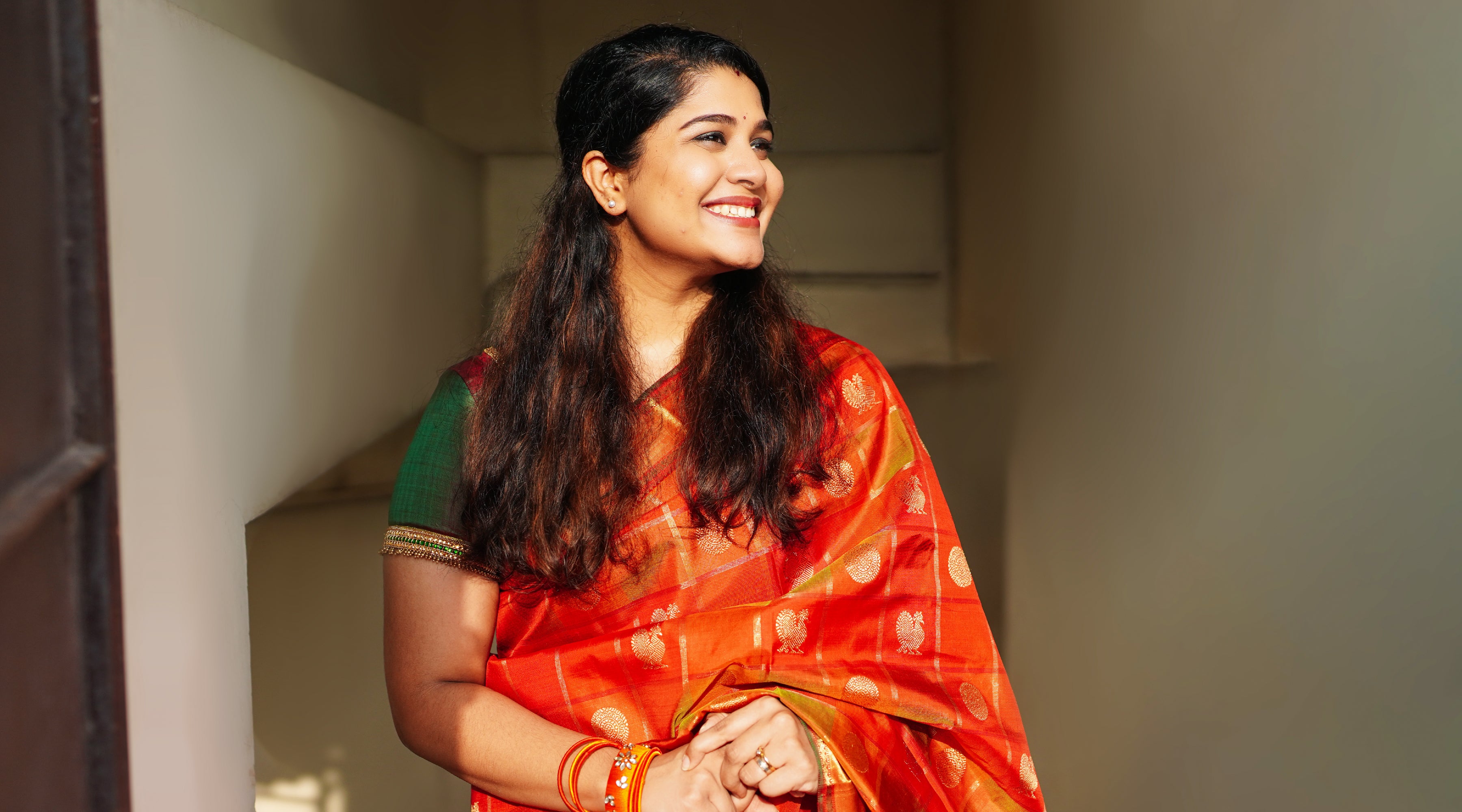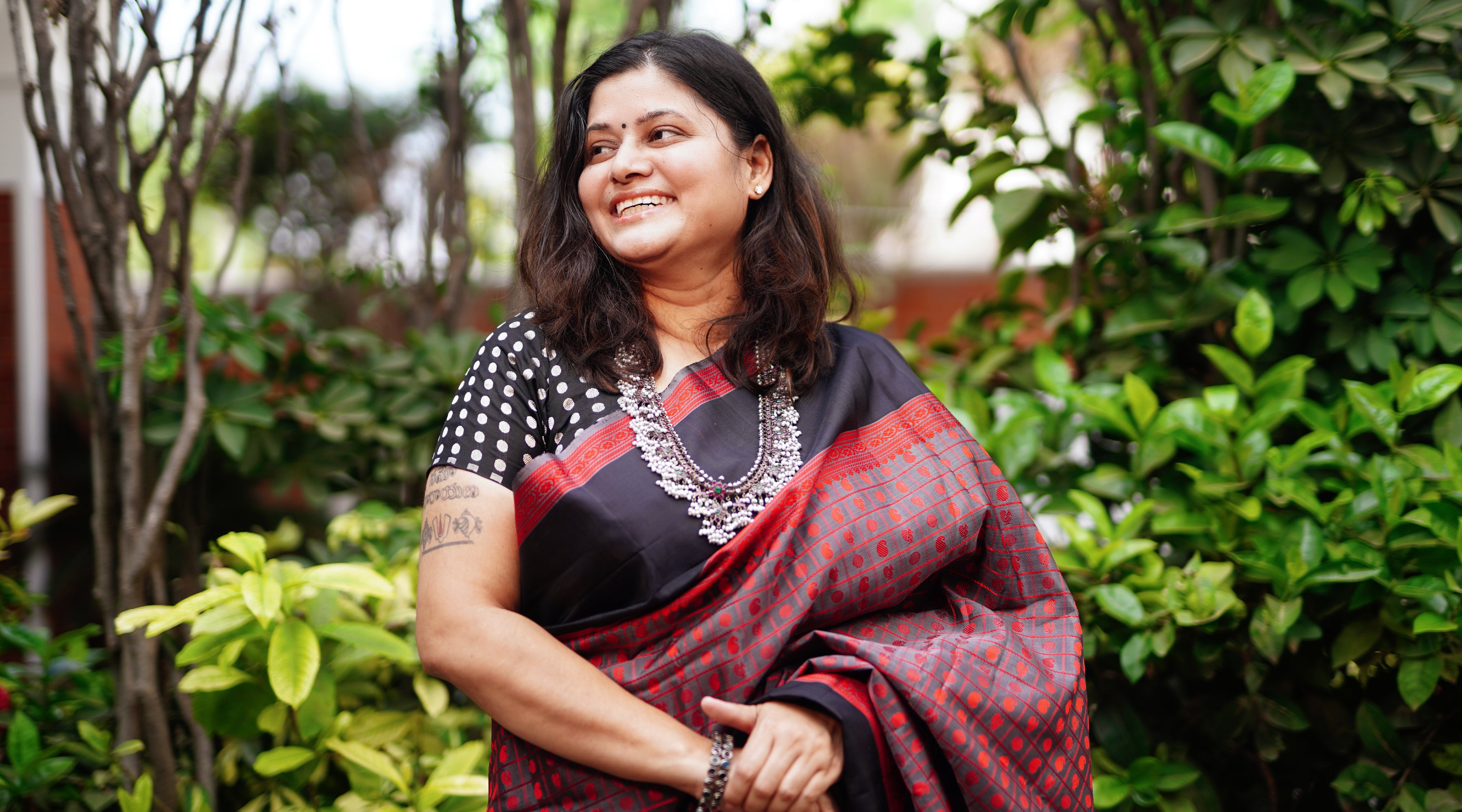KANAKAVALLI VIGNETTES : Shobha Viswanath - Once Upon A Story

Shobha Viswanath, Kanakavalli’s Vignette for March, is an author and the co-founder and publishing director of Karadi Tales, a publishing house that has transformed the landscape of children’s books and audiobooks in India. Shobha delights in bringing together music, art and text in the form of unforgettable stories for the child in every reader, young and old. In this conversation with Aneesha Bangera for The Kanakavalli Blog, Shobha tells us how Karadi Tales came to into being almost 25 years ago and why children’s books are not just for children. Beyond her work, Shobha’s volunteer work and her connection with her spiritual Guru nourish her. Travel invigorates her and feeds her creativity. For Shobha, beauty is elegant, easy and organic, while the sari is synonymous with celebration.
Taking a moment out of a busy schedule, Shobha curates a selection of Kanakavalli saris that reflect her deep love for beauty and tradition. Excerpts of the conversation below…
Once Upon A Story
Tell us about the genesis of Karadi Tales and the journey thus far.
I have a Master’s degree in Special Education, and spent some years living in the US where I taught both children and adults with visual impairments. I used a lot of audio books in my work, since my students couldn’t read. Listening to stories was not just a source of information for them, but also a form of entertainment. When my son was born, I introduced him to audio books too, observing how both illustration and text on the page grew familiar to him thanks to the sound cues in the audio. By the age of two-and-a-half, my son was not only reading but also writing!
On our return to India after seven years abroad, I began searching for audio books for my daughter and found almost none. Seeing the gap in the market, we decided to start something of our own. With my background in teaching and writing, and my husband’s family’s musical expertise, we had the core competence to start Karadi Tales. India is an absolute treasure trove of stories and we decided to retell beloved folk stories, from the Panchatantra to the Jataka tales. As I was collecting stories, I was puzzled by the fact that I couldn’t find any stories about bears, and thus was born Karadi (the word for bear in Tamil, Malayalam and Kannada), our very South Indian sutradhar or storyteller.

Above (Clockwise from top left): Shobha reading to her niece's young son; Shobha with her husband C.P. Viswanath; All smiles with her husband and her children.
A journey of 25 years cannot be covered in the context of this interview, but suffice it to say that Karadi is my last-born child and an offspring from whom I have learned more than from my other two children.
If one looks back and wonders if this was a life well-lived, if this was a journey that impacted and touched lives along the way, the answer is a definite yes. We started as a three-member team that has grown into an almost 300-people work force.

Above (left to right): A poster for 'Bandar Bindaas Bandar', a Karadi Tales music album for children; Shobha with her co-founders - husband C.P. Viswanath and brother-in-law Narayan Parasuram.
How does your love for literature marry with your love for art in the work that you do?
To be in the space of creating audio books and picture books for children is the ideal way to enjoy literature, music, and art. To bring stories to life through the marriage of text and art; to work with remarkable artists, writers and musicians, and to finally bring to existence finely crafted beautiful books that children enjoy reading and listening to again and again – who can ask for a better job?

Above (clockwise from top left): Shobha in the recording studio with Saeed Jaffrey; Shobha and Viswanath at the launch of the 'Wings of Fire' audiobook with President Abdul Kalam; With Vairamuthu and Anuradha Sriram at the Tamil launch of 'Wings of Fire'.
Why do you think that children's books aren't just for children, especially in the world we now live in?
I would think that in any world that we live in—the past, the present, or the future—keeping in touch with qualities that define being a child, is important. Children’s books allow us as adults to do that. It allows us to see that “wonder in the grain of sand”. I don’t think any child should be allowed to “graduate” from a picture book. And I think every adult must visit the picture book. I have discovered and enjoyed more picture books as an adult than I have as a child. It remains my favourite genre of all literature.
While text and illustration, writing and editing, take up much of your time, what place does music have in your life?
Music has become integral to my life not because I am a musician or even a student of music —I can’t sing to save my life—but because I have the good fortune of being married to a man who belongs to a family of musicians and is a musician himself. Viswanath’s youngest brother Narayan has created most of the music for Karadi Tales. Their band (Three Brothers & A Violin) and the brand (Karadi Tales) are synonymous with music for children in India. The songs and the music from our stories have travelled extensively, far beyond anything I could have ever imagined. A case in point is our song, “My name is Madhavi, I am from Alleppey…” which greets us wherever we go and has become ubiquitous at annual day celebrations in schools.

Above (clockwise from top): Shobha at a writers workshop in Bangalore; Recording in Kolkata with the legendary Usha Uthup; Shobha addressing a group of students at the Kitabo children's book festival in Jodhpur; Shobha teaching at Isha Home School.
How has travel informed and influenced you and your publishing work?
My visits to the international book fairs in Frankfurt and Bologna have definitely informed my approach to creating picture books. I grew up in India, Kuwait and Saudi Arabia, and post marriage have lived in the United States for a good number of years. As a publisher, I have had the opportunity to travel to several countries.
Hans Christian Andersen said that to travel is to live and I could not agree more. All destinations hold excitement, but having said that, the greatest destination is to return home.


Above (clockwise from top): Shobha and her husband in Chicago; Playing tourist in London; Shobha posing in Barcelona.
What does it mean to you to have a spiritual guide in your life? How has this journey changed you and your approach to the world?
Until I met Sadhguru, I was as sceptical of all spiritual people as the next urban, educated, so-called ‘intellectual’, without actually knowing anything about them. Like many others, I banded all leaders under the label of ‘godmen’, judging them as imposters. My first meeting with Sadhguru was accidental. My husband had gone for a yoga lesson and recommended it to me. Sadhguru was conducting the first class I attended, and every single thing he said made so much sense to me, felt so logical. There was nothing he said that I could counter with my own logic. I stayed with the yoga practices, and this deepened my experience, dramatically changing my perception of spiritual masters.
I’ve realised that we are often so quick to judge or jump to conclusions, but the truth is there is a lot we don’t know—a lot we don’t take the trouble to know. At the end of the day, it is a deeply personal connection between an individual and her Guru.
To have Sadhguru as a part of my life is my biggest blessing. I am still a ‘work-in-progress’ so I am not sure how it has changed me and my approach to the world. But I can’t imagine how my life would have been without Sadhguru in it. I don’t even want to imagine it.
How do you define beauty and tradition?
Elegance, ease, balance, organic, non-synthetic, real—all these define my idea of beauty as well as my own aesthetic. As for tradition, if I may paraphrase Sadhguru—he says that if one were to trace any tradition to its source, then one will discover its roots in the joyful experience of an individual or group of people.

A tradition therefore becomes valuable as an inspiration or it becomes the means for the present or future generations to arrive at the same experience. Combine this with beauty and you have something truly transformational and explosive.
What does the sari—and the kanjivaram in particular—mean to you?
Celebration. Joy. Beauty.
My first ever, tiny modelling stint was for a sari brand called Signora. I was working at Sobhagya Advertising, and Signora was a client with a store located just opposite our office. I joined the agency as an intern and ended up doing all manner of small jobs, including delivering things to clients. Before long, I was asked to model a few saris for Signora which I quite enjoyed doing. Much to my embarrassment though, I saw my face plastered across a huge billboard near the airport one day!

Above (clockwise from top left): Shobha's first modelling gig for Signora; A black & white still from a modelling feature; A shot of Shobha from the campaign for Kanakavalli's Reiya collective of vintage washed kanjivarams.
I started greying prematurely, and in my mid-forties decided to shave my head and then stop dyeing my hair. All the hair that grew back was salt and pepper, and more recently it is definitely more salt than pepper. I received many offers for modelling gigs, but neither did I have the time nor the inclination for it. But when Kanakavalli invited me to be a part of the Reiya campaign a couple of years ago, I was happy to do it. I’ve known Ahalya for ever so long, and that kanjivaram sari really was a stunner!
Tell us the story behind the Kanakavalli sari you chose for the Vignettes shoot.
This is one of my older saris, bought from Ahalya years ago. I remember walking in with a friend and Ahalya who greeted us showed me this black sari with a ganga jamuna border of mustard and red and a subdued pallu and said, “This one is for you, Shobha. I saw it and thought that it would look best on you. It has you written all over it.” And true enough, I saw it and fell in love with it. It had not been my intention to buy a sari that day but I ended up buying it and I am definitely not complaining!

Shobha is wearing a gorgeous kanjivaram woven with bands in black and off white. The ganga jamuna borders in mustard yellow and vermillion are shot with black and embellished with gold and black stripes.
- Shobha Viswanath, in conversation with Aneesha Bangera, photography by Raghuram Vedant.
View Shobha's accompanying guest curation here.



